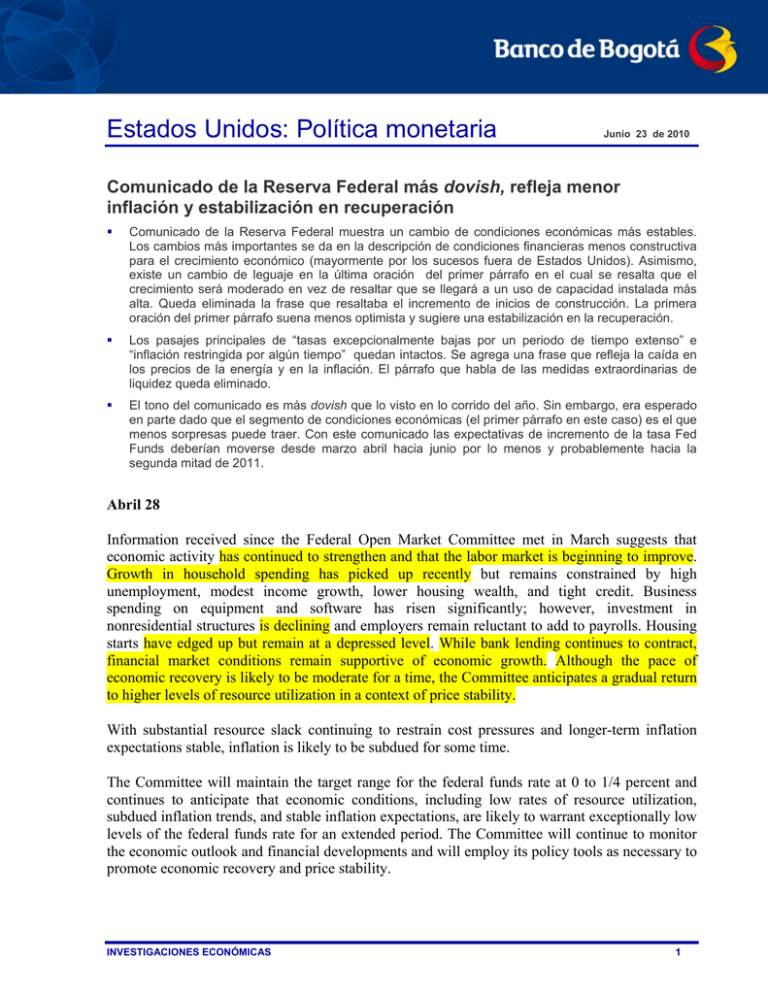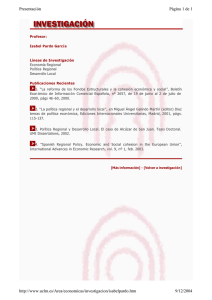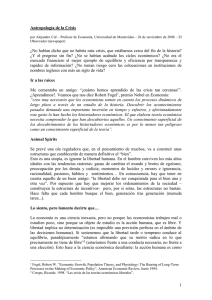Estados Unidos: Política monetaria
Anuncio

Estados Unidos: Política monetaria Junio 23 de 2010 Comunicado de la Reserva Federal más dovish, refleja menor inflación y estabilización en recuperación Comunicado de la Reserva Federal muestra un cambio de condiciones económicas más estables. Los cambios más importantes se da en la descripción de condiciones financieras menos constructiva para el crecimiento económico (mayormente por los sucesos fuera de Estados Unidos). Asimismo, existe un cambio de leguaje en la última oración del primer párrafo en el cual se resalta que el crecimiento será moderado en vez de resaltar que se llegará a un uso de capacidad instalada más alta. Queda eliminada la frase que resaltaba el incremento de inicios de construcción. La primera oración del primer párrafo suena menos optimista y sugiere una estabilización en la recuperación. Los pasajes principales de “tasas excepcionalmente bajas por un periodo de tiempo extenso” e “inflación restringida por algún tiempo” quedan intactos. Se agrega una frase que refleja la caída en los precios de la energía y en la inflación. El párrafo que habla de las medidas extraordinarias de liquidez queda eliminado. El tono del comunicado es más dovish que lo visto en lo corrido del año. Sin embargo, era esperado en parte dado que el segmento de condiciones económicas (el primer párrafo en este caso) es el que menos sorpresas puede traer. Con este comunicado las expectativas de incremento de la tasa Fed Funds deberían moverse desde marzo abril hacia junio por lo menos y probablemente hacia la segunda mitad de 2011. Abril 28 Information received since the Federal Open Market Committee met in March suggests that economic activity has continued to strengthen and that the labor market is beginning to improve. Growth in household spending has picked up recently but remains constrained by high unemployment, modest income growth, lower housing wealth, and tight credit. Business spending on equipment and software has risen significantly; however, investment in nonresidential structures is declining and employers remain reluctant to add to payrolls. Housing starts have edged up but remain at a depressed level. While bank lending continues to contract, financial market conditions remain supportive of economic growth. Although the pace of economic recovery is likely to be moderate for a time, the Committee anticipates a gradual return to higher levels of resource utilization in a context of price stability. With substantial resource slack continuing to restrain cost pressures and longer-term inflation expectations stable, inflation is likely to be subdued for some time. The Committee will maintain the target range for the federal funds rate at 0 to 1/4 percent and continues to anticipate that economic conditions, including low rates of resource utilization, subdued inflation trends, and stable inflation expectations, are likely to warrant exceptionally low levels of the federal funds rate for an extended period. The Committee will continue to monitor the economic outlook and financial developments and will employ its policy tools as necessary to promote economic recovery and price stability. INVESTIGACIONES ECONÓMICAS 1 In light of improved functioning of financial markets, the Federal Reserve has closed all but one of the special liquidity facilities that it created to support markets during the crisis. The only remaining such program, the Term Asset-Backed Securities Loan Facility, is scheduled to close on June 30 for loans backed by new-issue commercial mortgage-backed securities; it closed on March 31 for loans backed by all other types of collateral. Voting for the FOMC monetary policy action were: Ben S. Bernanke, Chairman; William C. Dudley, Vice Chairman; James Bullard; Elizabeth A. Duke; Donald L. Kohn; Sandra Pianalto; Eric S. Rosengren; Daniel K. Tarullo; and Kevin M. Warsh. Voting against the policy action was Thomas M. Hoenig, who believed that continuing to express the expectation of exceptionally low levels of the federal funds rate for an extended period was no longer warranted because it could lead to a build-up of future imbalances and increase risks to longer run macroeconomic and financial stability, while limiting the Committee’s flexibility to begin raising rates modestly. June 23 Information received since the Federal Open Market Committee met in April suggests that the economic recovery is proceeding and that the labor market is improving gradually. Household spending is increasing but remains constrained by high unemployment, modest income growth, lower housing wealth, and tight credit. Business spending on equipment and software has risen significantly; however, investment in nonresidential structures continues to be weak and employers remain reluctant to add to payrolls. Housing starts remain at a depressed level. Financial conditions have become less supportive of economic growth on balance, largely reflecting developments abroad. Bank lending has continued to contract in recent months. Nonetheless, the Committee anticipates a gradual return to higher levels of resource utilization in a context of price stability, although the pace of economic recovery is likely to be moderate for a time. Prices of energy and other commodities have declined somewhat in recent months, and underlying inflation has trended lower. With substantial resource slack continuing to restrain cost pressures and longer-term inflation expectations stable, inflation is likely to be subdued for some time. The Committee will maintain the target range for the federal funds rate at 0 to 1/4 percent and continues to anticipate that economic conditions, including low rates of resource utilization, subdued inflation trends, and stable inflation expectations, are likely to warrant exceptionally low levels of the federal funds rate for an extended period. The Committee will continue to monitor the economic outlook and financial developments and will employ its policy tools as necessary to promote economic recovery and price stability. Voting for the FOMC monetary policy action were: Ben S. Bernanke, Chairman; William C. Dudley, Vice Chairman; James Bullard; Elizabeth A. Duke; Donald L. Kohn; Sandra Pianalto; Eric S. Rosengren; Daniel K. Tarullo; and Kevin M. Warsh. Voting against the policy action was Thomas M. Hoenig, who believed that continuing to express the expectation of exceptionally low levels of the federal funds rate for an extended period was no longer warranted because it could INVESTIGACIONES ECONÓMICAS 2 lead to a build-up of future imbalances and increase risks to longer-run macroeconomic and financial stability, while limiting the Committee’s flexibility to begin raising rates modestly. Este documento ha sido realizado por los analistas del área de Investigaciones Económicas de la División de Internacional y Tesorería de Banco de Bogotá. La información contenida en el mismo está basada en fuentes consideradas confiables con respecto al comportamiento de la economía y de los mercados financieros. Sin embargo, su precisión no está garantizada y no constituye propuesta o recomendación alguna por parte de Banco de Bogotá para la negociación de sus productos y servicios. De igual forma, las opiniones expresadas no reflejan la opinión de Banco de Bogotá, por lo cual la entidad no se hace responsable de interpretaciones o de distorsiones que del presente informe hagan terceras personas. El uso de la información y cifras contenidas es exclusiva responsabilidad de cada usuario. Dirija sus inquietudes y comentarios a: [email protected] – 3446015 -16 -17 - 19 - 20 [email protected] - [email protected] - [email protected] [email protected] - [email protected] Banco de Bogotá: 3320032 | Tesorería ML/ME: 3445906 - 07 - 08 - 3446005 Mesa de Renta Fija: 3445909 - 10 - 11 - 12 - 13 | Mesa de Divisas: 3445901 - 02 - 03 - 04 – 05 Distribución: 3446114 - 15 - 16 - 17 - 20 | Estructuración Financiera: 3446010 - 12 Comercio Exterior: Inquietudes 3810500 Opción 3 / Productos 3320032 Ext. 3385 INVESTIGACIONES ECONÓMICAS 3


